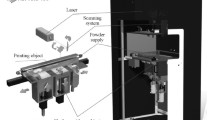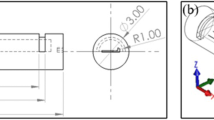Abstract
In the course of this research, the effect of the laser scanning speed (vc) on the morphology of single tracks obtained from a mixture of Ti and Al powders in a stoichiometric ratio of 1 : 1 in longitudinal and cross sections is studied. On the outer surface of the track, obtained at vc = 300 mm/s, droplets of splashed liquid are found, most likely caused by the release of gas bubbles that form due to the evaporation of more low-melting aluminum. With an increase in vc values up to 600 mm/s, a distortion of a single track along its length is observed. It is found that, with an increase in the speed of the laser beam, the tracks cease to be stable, and because of the significant Marangoni convection and the instability of the capillary liquid in the molten bath, “balls” are formed on the track surface. An increase in the laser speed leads to the appearance of pores, which are mainly concentrated in the formed balls, and they also influence the morphology of the track in the cross section, namely, the width, height of the track and the depth of penetration of the substrate. With an increase in the scanning speed from 300 to 900 mm/s, practically no penetration of the substrate is observed, the track width decreases from 194 to 136 μm, and its height increases almost 4 times (from 21 to 88 μm). To assess the structure of the tracks under study, X-ray spectral microanalysis (MRSA) is carried out and maps of the distribution of elements are obtained. It is found that, at scanning speeds of 300 and 600 mm/s, the mixing of the liquid in the bath of the melt is insufficient, which leads to the segregation of elements over the cross section of the tracks. The central zone turns out to be enriched in aluminum, while titanium predominates at the base, and in the extreme zone it is practically absent (4.57 at % Ti). For vc = 900 mm/s, according to the MRSA data, the presence of unmelted particles of titanium powder are observed. The presumable reason for this may be insufficient laser power at such a high scanning speed.





Similar content being viewed by others
REFERENCES
Holec, D., Legut, D., Isaeva, L., Souvatzis, P., Clemens, H., and Mayer, S., Interplay between effect of Mo and chemical disorder on the stability of β/β0-TiAl phase, Intermetallics, 2015, vol. 61, pp. 85–90. https://doi.org/10.1016/j.intermet.2015.03.001
Pflumm, R., Friedle, S., and Schütze, M., Oxidation protection of γ-TiAl-based alloys—A review, Intermetallics, 2015, vol. 56, pp. 1–14. https://doi.org/10.1016/j.intermet.2014.08.002
Shanmugasundaram, T., Guyon, J., Monchoux, J.P., Hazotte, A., and Bouzy, E., On grain refinement of a γ‑TiAl alloy using cryo-milling followed by spark plasma sintering, Intermetallics, 2015, vol. 66, pp. 141–148. https://doi.org/10.1016/j.intermet.2015.07.007
Kenel, C. and Leinenbach, C., Influence of Nb and Mo on microstructure formation of rapidly solidified ternary Ti–Al–(Nb, Mo) alloys, Intermetallics, 2016, vol. 69, pp. 82–89. https://doi.org/10.1016/j.intermet.2015.10.018
Appel, F., Clemens, H., and Fischer, F.D., Modeling concepts for intermetallic titanium aluminides, Prog. Mater. Sci., 2016, vol. 81, pp. 55–124. https://doi.org/10.1016/j.pmatsci.2016.01.001
Clemens, H. and Mayer, S., Design, processing, microstructure, properties, and applications of advanced intermetallic TiAl alloys, Adv. Eng. Mater., 2013, vol. 15, pp. 191–215. https://doi.org/10.1002/adem.201200231
Bewlay, B.P., Nag, S., Suzuki, A., and Weimer, M.J., TiAl alloys in commercial aircraft engines, Mater. High Temp., 2016, vol. 33, pp. 549–559. https://doi.org/10.1080/09603409.2016.1183068
Yang, Y., Wen, S., Wei, Q., Li, W., Liu, J., and Shi, Y., Effect of scan line spacing on texture, phase and nanohardness of TiAl/TiB2 metal matrix composites fabricated by selective laser melting, J. Alloys Compd., 2017, vol. 728, pp. 803–814. https://doi.org/10.1016/j.jallcom.2017.09.053
Li, W., Liu, J., Zhou, Y., Wen, S., Tan, J., Li, S., Wei, Q., Yan, C., and Shi, Y., Texture evolution, phase transformation mechanism and nanohardness of selective laser melted Ti–45Al–2Cr–5Nb alloy during multi-step heat treatment process, Intermetallics, 2017, vol. 85, pp. 130–138. https://doi.org/10.1016/j.intermet.2017.01.016
Li, W., Liu, J., Zhou, Y., Wen, S., Wei, Q., Yan, C., and Shi, Y., Effect of substrate preheating on the texture, phase and nanohardness of a Ti–45Al–2Cr–5Nb alloy processed by selective laser melting, Scr. Mater., 2016, vol. 118, pp. 13–18. https://doi.org/10.1016/j.scriptamat.2016.02.022
Yang, J., Han, J., Yu, H., Yin, J., Gao, M., Wang, Z., and Zeng, X., Role of molten pool mode on formability, microstructure and mechanical properties of selective laser melted Ti–6Al–4V alloy, Mater. Des., 2016, vol. 110, pp. 558–570. https://doi.org/10.1016/j.matdes.2016.08.036
Wu, J., Wang, X.Q., Wang, W., Attallah, M.M., and Loretto, M.H., Microstructure and strength of selectively laser melted AlSi10Mg, Acta Mater., 2016, vol. 117, pp. 311–320. https://doi.org/10.1016/j.actamat.2016.07.012
Wang, Z., Guan, K., Gao, M., Li, X., Chen, X., and Zeng, X., The microstructure and mechanical properties of deposited-IN718 by selective laser melting, J. Alloys Compd., 2012, vol. 513, pp. 518–523. https://doi.org/10.1016/j.jallcom.2011.10.107
Zhou, Y., Wen, S.F., Song, B., Zhou, X., Teng, Q., Wei, Q.S., and Shi, Y.S., A novel titanium alloy manufactured by selective laser melting: Microstructure, high temperature oxidation resistance, Mater. Des., 2016, vol. 89, pp. 1199–1204. https://doi.org/10.1016/j.matdes.2015.10.092
Ma, Y., Cuiuri, D., Hoye, N., Li, H.J., and Pan, Z.X., The effect of location on the microstructure and mechanical properties of titanium aluminides produced by additive layer manufacturing using in-situ alloying and gas tungsten arc welding, Mater. Sci. Eng., A, 2015, vol. 631, pp. 230–240. https://doi.org/10.1016/j.msea.2015.02.051
Löber, L., Schimansky, F.P., Kühn, U., Pyczak, F., and Eckert, J., Selective laser melting of a beta-solidifying TNM-B1 titanium aluminide alloy, J. Mater. Process. Technol., 2014, vol. 214, pp. 1852–1860. https://doi.org/10.1016/j.jmatprotec.2014.04.002
Löber, L., Biamino, S., Ackelid, U., Sabbadini, S., Epicoco, P., Fino, P., and Eckert, J., Comparison of selective laser and electron beam melted titanium aluminides, Proc. 22nd Int. Symposium Solid on Freeform Fabrication, Austin, TX, 2011, pp. 547–556.
Gussone, J., Hagedorn, Y.C., Gherekhloo, H., Kasperovich, G., Merzouk, T., and Hausmann, J., Microstructure of γ-titanium aluminide processed by selective laser melting at elevated temperatures, Intermetallics, 2015, vol. 66, pp. 133–140. https://doi.org/10.1016/j.intermet.2015.07.005
Li, W., Liu, J., Wen, S.F., Wei, Q.S., Yan, C.Z., and Shi, Y.S., Crystal orientation, crystallographic texture and phase evolution in the Ti-45Al-2Cr-5Nb alloy processed by selective laser melting, Mater. Charact., 2016, vol. 113, pp. 125–133. https://doi.org/10.1016/j.matchar.2016.01.012
Gu, D.D., Hagedorn, Y.C., Meiners, W., Meng, G.B., Batista, R.J.S., Wissenbach, K., and Poprawe, R., Densification behavior, microstructure evolution, and wear performance of selective laser melting processed commercially pure titanium, Acta Mater., 2012, vol. 60, pp. 3849–3860. https://doi.org/10.1016/j.actamat.2012.04.006
Shi, X., Ma, S., Liu, C., and Wu, Q., Parameter optimization for Ti–47Al–2Cr–2Nb in selective laser melting based on geometric characteristics of single scan tracks, Opt. Laser Technol., 2017, vol. 90, pp. 71–79. https://doi.org/10.1016/j.optlastec.2016.11.002
Thomas, M., Progress in the understanding of the microstructure evolution of direct laser fabricated TiAl, Mater. Sci. Forum, 2016, vol. 879, pp. 1939–1944. https://doi.org/10.4028/www.scientific.net/MSF.879.1939
Casalino, G., Campanelli, S.L., and Ludovico, A.D., Laser-arc hybrid welding of wrought to selective laser melt stainless steel, Int. J. Adv. Manuf. Technol., 2013, vol. 68, pp. 209–216. https://doi.org/10.1007/s00170-012-4721-z
Gusarov, A.V., Yadroitsev, I., Bertrand, P., and Smurov, I., Heat transfer modelling and stability analysis of selective laser melting, Appl. Surf. Sci., 2007, vol. 254, pp. 975–979. https://doi.org/10.1016/j.apsusc.2007.08.074
Funding
This study was carried out with financial support from the Russian Foundation for Basic Research as part of scientific project no. 20-33-90077.
Author information
Authors and Affiliations
Corresponding author
Ethics declarations
The authors declare that they have no conflict of interest.
About this article
Cite this article
Dolbachev, A.P., Belov, N.A. & Hakobyan, T.K. Experimental Study of Single Tracks Obtained from a Mixture of Ti and Al Powders with Variable Parameters of the Selective Laser Melting Process. Russ. J. Non-ferrous Metals 62, 539–544 (2021). https://doi.org/10.3103/S1067821221050047
Received:
Revised:
Accepted:
Published:
Issue Date:
DOI: https://doi.org/10.3103/S1067821221050047




